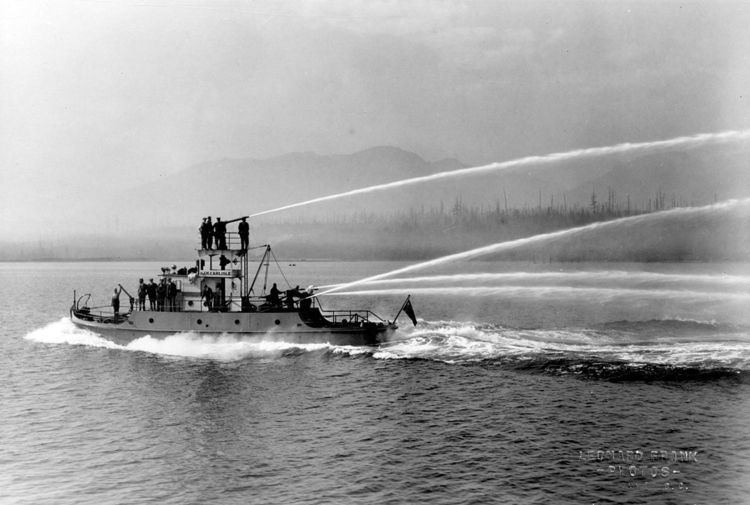 | ||
The city of Vancouver, British Columbia has operated fireboats since 1928, when the city introduced the J.H. Carlisle. At the time, the shores of False Creek where lined with industrial facilities, mainly sawmills. The owners of these businesses committed to pay for the construction of a fireboat provided it would be stationed in False Creek, as the boat's presence reduced the cost of their fire insurance. The new fireboat was named in honour of Vancouver's longest serving fire chief, John Howe Carlisle.
The J.H. Carlisle remained in service until 1971, while Fireboat No. 2, built in 1951, worked until 1987 when it was sold to the city of San Francisco, where it is still in service today as the Guardian. In 1992 the city of Vancouver received 5 new fireboats. Designed by Robert Allan Ltd. and built by Celtic Shipyards, the new boats served not only Vancouver but operated throughout the Lower Mainland as part of a new consortium between the cities of Vancouver, Port Moody, Burnaby, and the city and district of North Vancouver.
By 2015 four of the 1992-built boats where still in service, but had exceeded their planned twenty year operational life. The vessels had such low pumping capacity that authorities would dispatch two boats to each fire. In 2016 it was announced that the city would receive two new fireboats built by MetalCraft Marine of Kingston, Ontario. The boats would replace three of the remaining 1992-built boats, while one would be kept as a reserve. Ironically the 2nd of the new boats caught fire during transport, delaying it's delivery by several months. The first of the new boats entered service in September, 2016. The boat will eventually receive a name, making it only the second Vancouver fireboat to receive a name rather than a number.
Notable Events
On July 7, 1938 CPR Pier D caught fire. The J.H. Carlisle together with crews on land battled what was described as Vancouver's "most spectacular fire" for hours. At one point the heat grew so intense that four firefighters battling the blaze from a raft where forced to leap into the water after their hose was burned through.
On March 6, 1945 the freighter 'Greenhill Park' exploded at a pier on Burrard Inlet. The blast killed 8 longshoremen, injured a further 19 and shattered windows across the city. With WWII still in it's final stages, many initially thought the explosion was the result of a Japanese attack.
In 1959 the Norwegian freighter 'Ferngulf' exploded in Burrard Inlet, killing two and seriously wounding several more. There was no intervention by the city's fireboats or other rescue personnel. A city inquiry determined that the city's rules only allowed the fireboat to leave the city when directed to do so by the Mayor. Changes were made to the Canada Shipping Act, empowering a "rescue coordinator" to order rescue vessels to sea.
On July 3, 1960 a fire broke out at the BC Forrest Products Mill on the South shore of False Creek, resulting in Vancouver's first five-alarm fire. Both the J.H. Carlisle and Fireboat No. 2 responded. The fire was contained although most of the mill was burnt down before it could be extinguished.
On March 4, 2015 a fire broke out in a container containing trichloroisocyanuric acid at Port of Vancouver. Warnings were issued to people living in the vicinity to stay at home and lock their doors and windows to prevent gas from entering. Fireboats 3 and 5 attended, and together with crews on land, where able to extinguish the blaze with minimal damage.
